Strategic Management Tools and Analysis
VerifiedAdded on 2020/06/05
|20
|5574
|51
AI Summary
This assignment delves into the world of strategic management by examining commonly used tools such as the BCG Growth-Share Matrix, SWOT analysis, and Ansoff matrix. It provides a comprehensive overview of each tool, explaining its purpose, application, and benefits in analyzing business situations. The document also includes illustrative examples to demonstrate how these tools are implemented in real-world scenarios.
Contribute Materials
Your contribution can guide someone’s learning journey. Share your
documents today.

BUSINESS STRATEGY
Secure Best Marks with AI Grader
Need help grading? Try our AI Grader for instant feedback on your assignments.

TABLE OF CONTENTS
INTRODUCTION...........................................................................................................................1
TASK 1............................................................................................................................................1
1.1 Evaluation of business vision, mission, objectives and core competencies to inform
strategic planning....................................................................................................................1
1.2 Analysis of the factors to be recognised to formulate strategic planning.........................2
1.3 Evaluation of effectiveness of techniques to inform strategic planning...........................3
TASK 2............................................................................................................................................6
2.1 Analysis of strategic positioning of Volkswagen.............................................................6
2.2 Creation of environmental audit.......................................................................................9
2.3 Evaluation of major significance of stakeholder analysis..............................................10
2.4 Presentation of new business strategy for company.......................................................11
TASK 3..........................................................................................................................................12
3.1 Analysis of appropriateness of alternative strategies.....................................................12
3.2 Justification for the selection of appropriate strategy.....................................................12
TASK 4..........................................................................................................................................13
4.1 Assessment of roles and responsibilities of personnel ..................................................13
4.2 Analysis of needs of resources to meet the strategies....................................................13
4.3 Evaluation of the contribution of SMART goals...........................................................14
REFERENCES..............................................................................................................................16
Illustration Index
Illustration 1: BCG growth matrix...................................................................................................5
Illustration 2: SWOT analysis..........................................................................................................8
Illustration 3: Ansoff matrix..........................................................................................................11
INTRODUCTION...........................................................................................................................1
TASK 1............................................................................................................................................1
1.1 Evaluation of business vision, mission, objectives and core competencies to inform
strategic planning....................................................................................................................1
1.2 Analysis of the factors to be recognised to formulate strategic planning.........................2
1.3 Evaluation of effectiveness of techniques to inform strategic planning...........................3
TASK 2............................................................................................................................................6
2.1 Analysis of strategic positioning of Volkswagen.............................................................6
2.2 Creation of environmental audit.......................................................................................9
2.3 Evaluation of major significance of stakeholder analysis..............................................10
2.4 Presentation of new business strategy for company.......................................................11
TASK 3..........................................................................................................................................12
3.1 Analysis of appropriateness of alternative strategies.....................................................12
3.2 Justification for the selection of appropriate strategy.....................................................12
TASK 4..........................................................................................................................................13
4.1 Assessment of roles and responsibilities of personnel ..................................................13
4.2 Analysis of needs of resources to meet the strategies....................................................13
4.3 Evaluation of the contribution of SMART goals...........................................................14
REFERENCES..............................................................................................................................16
Illustration Index
Illustration 1: BCG growth matrix...................................................................................................5
Illustration 2: SWOT analysis..........................................................................................................8
Illustration 3: Ansoff matrix..........................................................................................................11
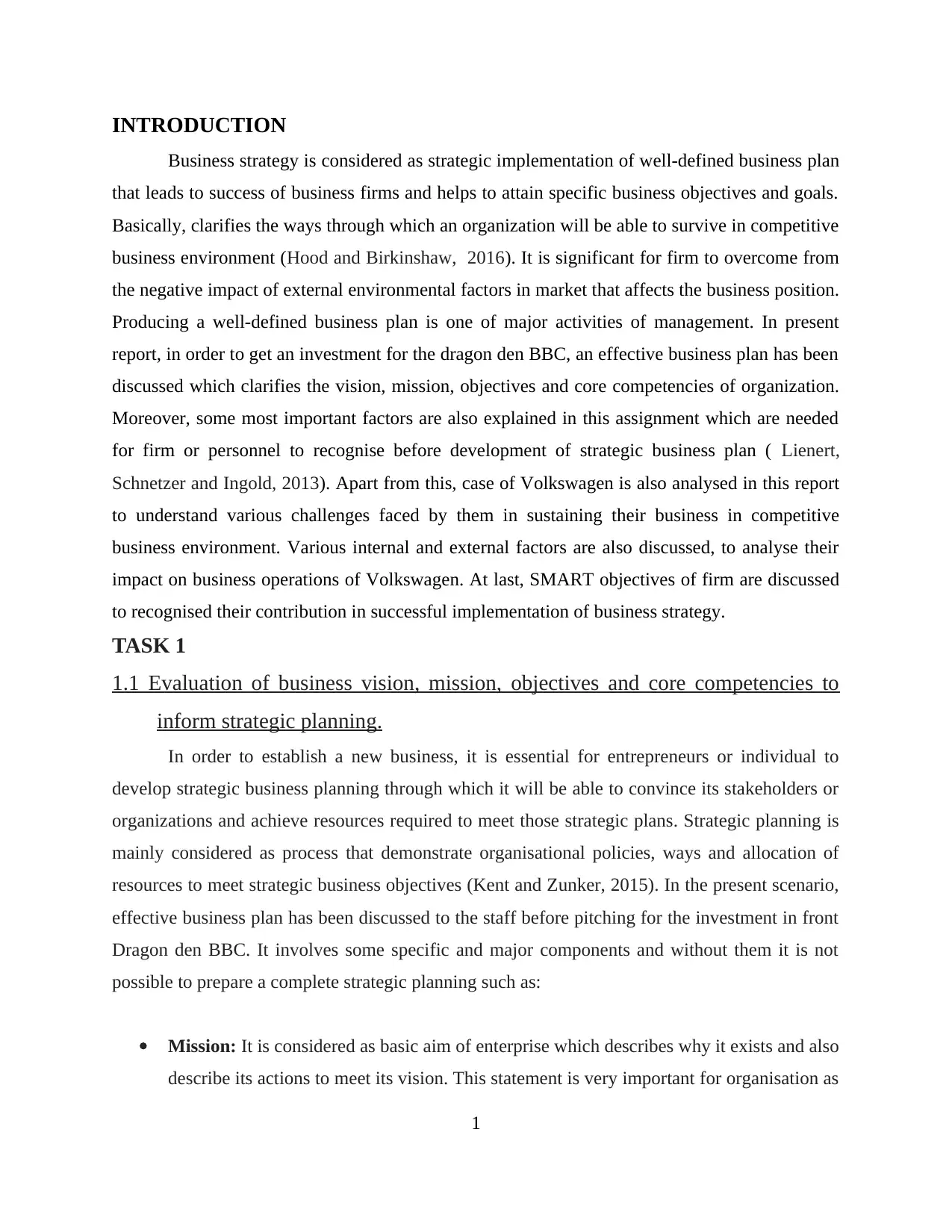
INTRODUCTION
Business strategy is considered as strategic implementation of well-defined business plan
that leads to success of business firms and helps to attain specific business objectives and goals.
Basically, clarifies the ways through which an organization will be able to survive in competitive
business environment (Hood and Birkinshaw, 2016). It is significant for firm to overcome from
the negative impact of external environmental factors in market that affects the business position.
Producing a well-defined business plan is one of major activities of management. In present
report, in order to get an investment for the dragon den BBC, an effective business plan has been
discussed which clarifies the vision, mission, objectives and core competencies of organization.
Moreover, some most important factors are also explained in this assignment which are needed
for firm or personnel to recognise before development of strategic business plan ( Lienert,
Schnetzer and Ingold, 2013). Apart from this, case of Volkswagen is also analysed in this report
to understand various challenges faced by them in sustaining their business in competitive
business environment. Various internal and external factors are also discussed, to analyse their
impact on business operations of Volkswagen. At last, SMART objectives of firm are discussed
to recognised their contribution in successful implementation of business strategy.
TASK 1
1.1 Evaluation of business vision, mission, objectives and core competencies to
inform strategic planning.
In order to establish a new business, it is essential for entrepreneurs or individual to
develop strategic business planning through which it will be able to convince its stakeholders or
organizations and achieve resources required to meet those strategic plans. Strategic planning is
mainly considered as process that demonstrate organisational policies, ways and allocation of
resources to meet strategic business objectives (Kent and Zunker, 2015). In the present scenario,
effective business plan has been discussed to the staff before pitching for the investment in front
Dragon den BBC. It involves some specific and major components and without them it is not
possible to prepare a complete strategic planning such as:
Mission: It is considered as basic aim of enterprise which describes why it exists and also
describe its actions to meet its vision. This statement is very important for organisation as
1
Business strategy is considered as strategic implementation of well-defined business plan
that leads to success of business firms and helps to attain specific business objectives and goals.
Basically, clarifies the ways through which an organization will be able to survive in competitive
business environment (Hood and Birkinshaw, 2016). It is significant for firm to overcome from
the negative impact of external environmental factors in market that affects the business position.
Producing a well-defined business plan is one of major activities of management. In present
report, in order to get an investment for the dragon den BBC, an effective business plan has been
discussed which clarifies the vision, mission, objectives and core competencies of organization.
Moreover, some most important factors are also explained in this assignment which are needed
for firm or personnel to recognise before development of strategic business plan ( Lienert,
Schnetzer and Ingold, 2013). Apart from this, case of Volkswagen is also analysed in this report
to understand various challenges faced by them in sustaining their business in competitive
business environment. Various internal and external factors are also discussed, to analyse their
impact on business operations of Volkswagen. At last, SMART objectives of firm are discussed
to recognised their contribution in successful implementation of business strategy.
TASK 1
1.1 Evaluation of business vision, mission, objectives and core competencies to
inform strategic planning.
In order to establish a new business, it is essential for entrepreneurs or individual to
develop strategic business planning through which it will be able to convince its stakeholders or
organizations and achieve resources required to meet those strategic plans. Strategic planning is
mainly considered as process that demonstrate organisational policies, ways and allocation of
resources to meet strategic business objectives (Kent and Zunker, 2015). In the present scenario,
effective business plan has been discussed to the staff before pitching for the investment in front
Dragon den BBC. It involves some specific and major components and without them it is not
possible to prepare a complete strategic planning such as:
Mission: It is considered as basic aim of enterprise which describes why it exists and also
describe its actions to meet its vision. This statement is very important for organisation as
1

it inspires employees to work make a coordination and make their focus on achievement
of company's vision. For example: A mission of retail enterprise is “to provide unique
and fashionable brand products in order to satisfy the customers' demand and
achievement of market share to become a leader in fashion retail industry”.
Vision: It is considered as the outline of organization which clarifies its future desired
position in a particular industry or business. It also provides understanding about what the
firm wants to achieve in a specific time frame (Wæraas, 2015). For example: vision
statements of retail fashion brands are “to become a market leader by providing the
satisfaction to customers by accomplishing their demand and achieve the highest
probability in retail industry..
Objectives: It is an end result which is the measure of progress which is required to meet
the targets of an organization. These are also considered as steps through which a
business enterprise will ultimately meet those business plans.
Core competencies: It mainly provides competitive advantages over other companies to
sustain in competitive market situation. If any organization have competitiveness then it
is clear that it will able to sustain in their desire market. For example; The major abilities
of retails fashion brands are its quality of products, well developed marketing channels,
competitive prices, qualified employees and effective after sale services etc. It is
considered as essential element to gain success as it acts as cross functional process of
business.
Thus, these major components will help them to influence the financial organization
Dragon den BBC to attain the resources required for accomplishment of business plan.
1.2 Analysis of the factors to be recognised to formulate strategic planning.
In competitive business environment, companies also have to face some challenges or
issues while formulation strategic business plan. There are some issues involved in strategic
planning and those issues must be resolved properly by setting priorities in terms of importance
and time. Sometimes it is difficult to achieve business objectives as there are some major issues
they have to face while implementation of policies and procedures (Norton, 2014). In this
context, for achievement of success in business plans there are some important factors that have
been discussed which the personnel or company have to analyse while accomplishment of
strategic planning such as:
2
of company's vision. For example: A mission of retail enterprise is “to provide unique
and fashionable brand products in order to satisfy the customers' demand and
achievement of market share to become a leader in fashion retail industry”.
Vision: It is considered as the outline of organization which clarifies its future desired
position in a particular industry or business. It also provides understanding about what the
firm wants to achieve in a specific time frame (Wæraas, 2015). For example: vision
statements of retail fashion brands are “to become a market leader by providing the
satisfaction to customers by accomplishing their demand and achieve the highest
probability in retail industry..
Objectives: It is an end result which is the measure of progress which is required to meet
the targets of an organization. These are also considered as steps through which a
business enterprise will ultimately meet those business plans.
Core competencies: It mainly provides competitive advantages over other companies to
sustain in competitive market situation. If any organization have competitiveness then it
is clear that it will able to sustain in their desire market. For example; The major abilities
of retails fashion brands are its quality of products, well developed marketing channels,
competitive prices, qualified employees and effective after sale services etc. It is
considered as essential element to gain success as it acts as cross functional process of
business.
Thus, these major components will help them to influence the financial organization
Dragon den BBC to attain the resources required for accomplishment of business plan.
1.2 Analysis of the factors to be recognised to formulate strategic planning.
In competitive business environment, companies also have to face some challenges or
issues while formulation strategic business plan. There are some issues involved in strategic
planning and those issues must be resolved properly by setting priorities in terms of importance
and time. Sometimes it is difficult to achieve business objectives as there are some major issues
they have to face while implementation of policies and procedures (Norton, 2014). In this
context, for achievement of success in business plans there are some important factors that have
been discussed which the personnel or company have to analyse while accomplishment of
strategic planning such as:
2
Paraphrase This Document
Need a fresh take? Get an instant paraphrase of this document with our AI Paraphraser

Analysis of market environment: Most essential factors that provides clear
understanding that an organisation needs to consider the market environment in which it
operates and wants to expand its business operations (Yang, 2017). For example: Retail
fashion brand needs to consider the demand of products and services, economic condition
of target segment, competitors policies etc. for development of effective business plan.
Positive business environment will provide major support to organisation in achievement
of business objectives.
Competitors analysis: It is also an essential factor which is to be considered by every
business organization or personnel for making successful business strategies. In this, the
firms have to analyse the policies and ways of its competitors in particular industry to
influence customers and achievement of target sale of products in market ( Wüstemeyer,
Madlener and Bunn, 2015). For example: the retail fashion brand needs to analyse the
competitors’ products, price and policies through which they are sustaining in market. It
helps the brand to make changes in their policies so that they will be able to establish
their business operations.
Allocation of the budget for the plans: Before formulation of strategies or plans
managers have to identify and allocate funds to accomplish those plans. A proper budget
has to be formulated by the managers for various activities before formulation of plans.
Stakeholders analysis: In order to develop effective business plans and policies the
personnel or company needs to analyse its stakeholders in market and also analyse their
impact on regulations of business operations within industry. For example: Stakeholders
of fashion brand will be its suppliers, employees, competitors, government and
shareholders etc.
1.3 Evaluation of effectiveness of techniques to inform strategic planning.
In international market, various business plans have developed by the companies for
establishment and expansion of operations in domestic country and achievement of market share
as compared to rivals. To increase the growth of company and influence the customers the
companies has to take various business decisions through which they have been able to achieve
the business objectives ( Dong-Hun, 2010). In this context, the company has to analyse some
effective of techniques which they have used to develop strategic planning and analyse the
3
understanding that an organisation needs to consider the market environment in which it
operates and wants to expand its business operations (Yang, 2017). For example: Retail
fashion brand needs to consider the demand of products and services, economic condition
of target segment, competitors policies etc. for development of effective business plan.
Positive business environment will provide major support to organisation in achievement
of business objectives.
Competitors analysis: It is also an essential factor which is to be considered by every
business organization or personnel for making successful business strategies. In this, the
firms have to analyse the policies and ways of its competitors in particular industry to
influence customers and achievement of target sale of products in market ( Wüstemeyer,
Madlener and Bunn, 2015). For example: the retail fashion brand needs to analyse the
competitors’ products, price and policies through which they are sustaining in market. It
helps the brand to make changes in their policies so that they will be able to establish
their business operations.
Allocation of the budget for the plans: Before formulation of strategies or plans
managers have to identify and allocate funds to accomplish those plans. A proper budget
has to be formulated by the managers for various activities before formulation of plans.
Stakeholders analysis: In order to develop effective business plans and policies the
personnel or company needs to analyse its stakeholders in market and also analyse their
impact on regulations of business operations within industry. For example: Stakeholders
of fashion brand will be its suppliers, employees, competitors, government and
shareholders etc.
1.3 Evaluation of effectiveness of techniques to inform strategic planning.
In international market, various business plans have developed by the companies for
establishment and expansion of operations in domestic country and achievement of market share
as compared to rivals. To increase the growth of company and influence the customers the
companies has to take various business decisions through which they have been able to achieve
the business objectives ( Dong-Hun, 2010). In this context, the company has to analyse some
effective of techniques which they have used to develop strategic planning and analyse the
3
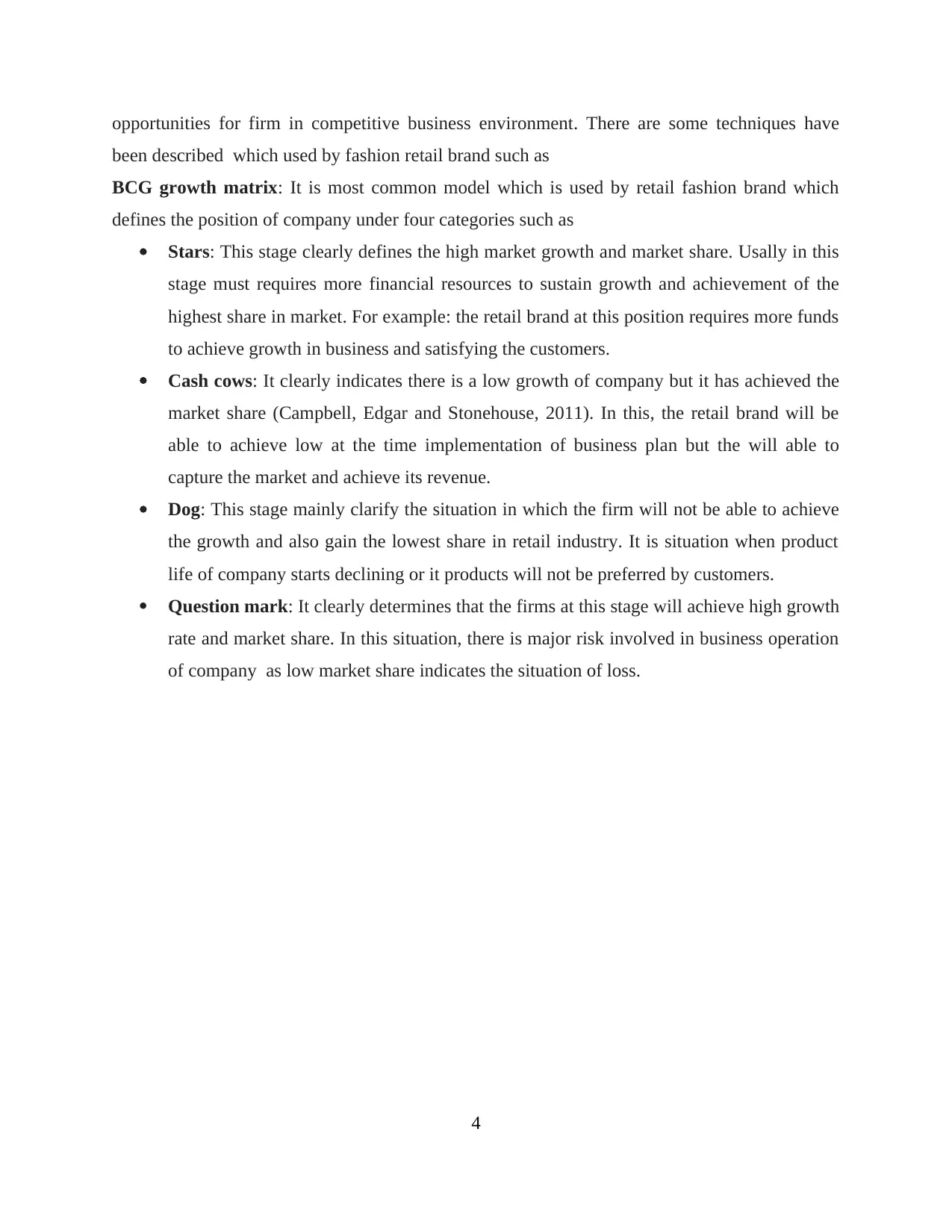
opportunities for firm in competitive business environment. There are some techniques have
been described which used by fashion retail brand such as
BCG growth matrix: It is most common model which is used by retail fashion brand which
defines the position of company under four categories such as
Stars: This stage clearly defines the high market growth and market share. Usally in this
stage must requires more financial resources to sustain growth and achievement of the
highest share in market. For example: the retail brand at this position requires more funds
to achieve growth in business and satisfying the customers.
Cash cows: It clearly indicates there is a low growth of company but it has achieved the
market share (Campbell, Edgar and Stonehouse, 2011). In this, the retail brand will be
able to achieve low at the time implementation of business plan but the will able to
capture the market and achieve its revenue.
Dog: This stage mainly clarify the situation in which the firm will not be able to achieve
the growth and also gain the lowest share in retail industry. It is situation when product
life of company starts declining or it products will not be preferred by customers.
Question mark: It clearly determines that the firms at this stage will achieve high growth
rate and market share. In this situation, there is major risk involved in business operation
of company as low market share indicates the situation of loss.
4
been described which used by fashion retail brand such as
BCG growth matrix: It is most common model which is used by retail fashion brand which
defines the position of company under four categories such as
Stars: This stage clearly defines the high market growth and market share. Usally in this
stage must requires more financial resources to sustain growth and achievement of the
highest share in market. For example: the retail brand at this position requires more funds
to achieve growth in business and satisfying the customers.
Cash cows: It clearly indicates there is a low growth of company but it has achieved the
market share (Campbell, Edgar and Stonehouse, 2011). In this, the retail brand will be
able to achieve low at the time implementation of business plan but the will able to
capture the market and achieve its revenue.
Dog: This stage mainly clarify the situation in which the firm will not be able to achieve
the growth and also gain the lowest share in retail industry. It is situation when product
life of company starts declining or it products will not be preferred by customers.
Question mark: It clearly determines that the firms at this stage will achieve high growth
rate and market share. In this situation, there is major risk involved in business operation
of company as low market share indicates the situation of loss.
4
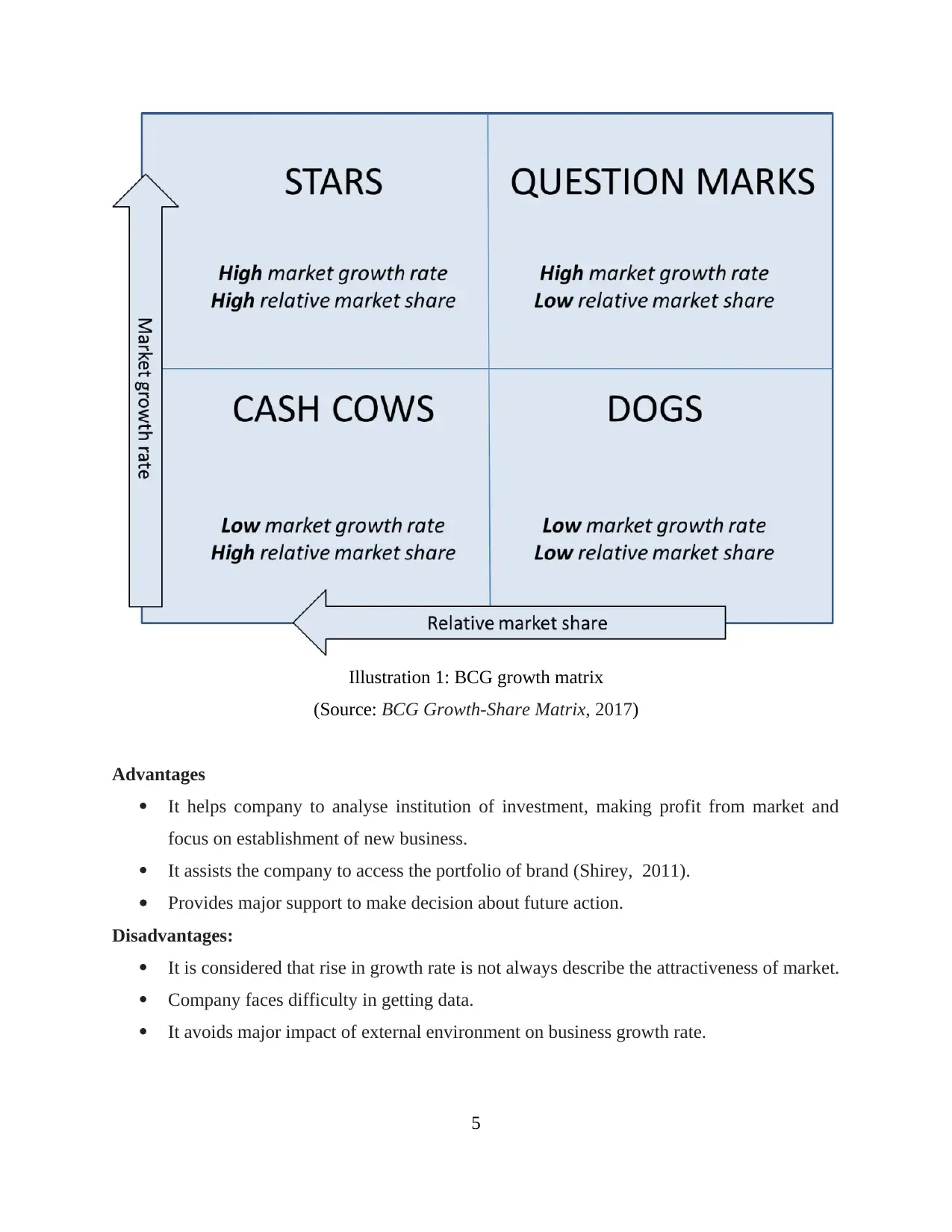
Advantages
It helps company to analyse institution of investment, making profit from market and
focus on establishment of new business.
It assists the company to access the portfolio of brand (Shirey, 2011).
Provides major support to make decision about future action.
Disadvantages:
It is considered that rise in growth rate is not always describe the attractiveness of market.
Company faces difficulty in getting data.
It avoids major impact of external environment on business growth rate.
5
Illustration 1: BCG growth matrix
(Source: BCG Growth-Share Matrix, 2017)
It helps company to analyse institution of investment, making profit from market and
focus on establishment of new business.
It assists the company to access the portfolio of brand (Shirey, 2011).
Provides major support to make decision about future action.
Disadvantages:
It is considered that rise in growth rate is not always describe the attractiveness of market.
Company faces difficulty in getting data.
It avoids major impact of external environment on business growth rate.
5
Illustration 1: BCG growth matrix
(Source: BCG Growth-Share Matrix, 2017)
Secure Best Marks with AI Grader
Need help grading? Try our AI Grader for instant feedback on your assignments.
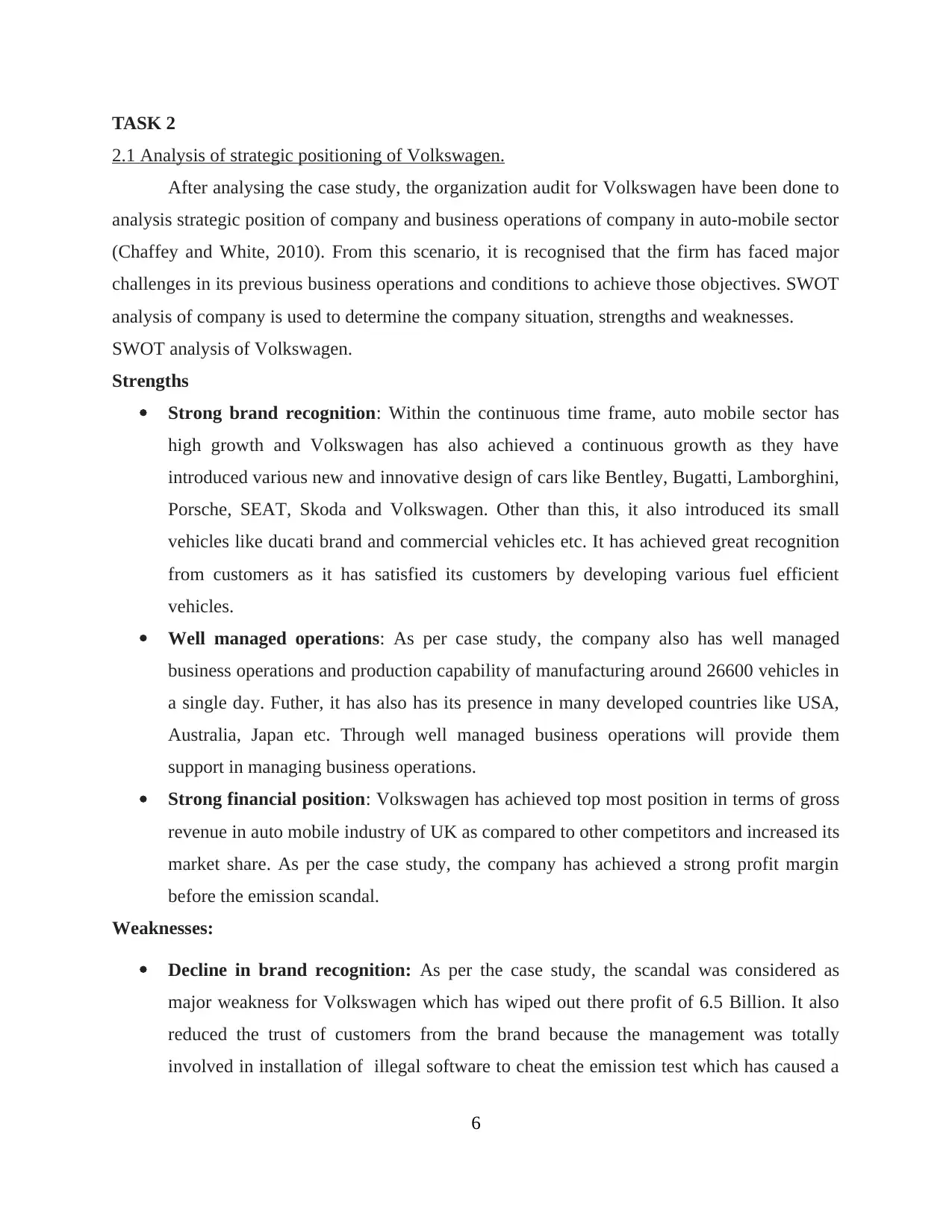
TASK 2
2.1 Analysis of strategic positioning of Volkswagen.
After analysing the case study, the organization audit for Volkswagen have been done to
analysis strategic position of company and business operations of company in auto-mobile sector
(Chaffey and White, 2010). From this scenario, it is recognised that the firm has faced major
challenges in its previous business operations and conditions to achieve those objectives. SWOT
analysis of company is used to determine the company situation, strengths and weaknesses.
SWOT analysis of Volkswagen.
Strengths
Strong brand recognition: Within the continuous time frame, auto mobile sector has
high growth and Volkswagen has also achieved a continuous growth as they have
introduced various new and innovative design of cars like Bentley, Bugatti, Lamborghini,
Porsche, SEAT, Skoda and Volkswagen. Other than this, it also introduced its small
vehicles like ducati brand and commercial vehicles etc. It has achieved great recognition
from customers as it has satisfied its customers by developing various fuel efficient
vehicles.
Well managed operations: As per case study, the company also has well managed
business operations and production capability of manufacturing around 26600 vehicles in
a single day. Futher, it has also has its presence in many developed countries like USA,
Australia, Japan etc. Through well managed business operations will provide them
support in managing business operations.
Strong financial position: Volkswagen has achieved top most position in terms of gross
revenue in auto mobile industry of UK as compared to other competitors and increased its
market share. As per the case study, the company has achieved a strong profit margin
before the emission scandal.
Weaknesses:
Decline in brand recognition: As per the case study, the scandal was considered as
major weakness for Volkswagen which has wiped out there profit of 6.5 Billion. It also
reduced the trust of customers from the brand because the management was totally
involved in installation of illegal software to cheat the emission test which has caused a
6
2.1 Analysis of strategic positioning of Volkswagen.
After analysing the case study, the organization audit for Volkswagen have been done to
analysis strategic position of company and business operations of company in auto-mobile sector
(Chaffey and White, 2010). From this scenario, it is recognised that the firm has faced major
challenges in its previous business operations and conditions to achieve those objectives. SWOT
analysis of company is used to determine the company situation, strengths and weaknesses.
SWOT analysis of Volkswagen.
Strengths
Strong brand recognition: Within the continuous time frame, auto mobile sector has
high growth and Volkswagen has also achieved a continuous growth as they have
introduced various new and innovative design of cars like Bentley, Bugatti, Lamborghini,
Porsche, SEAT, Skoda and Volkswagen. Other than this, it also introduced its small
vehicles like ducati brand and commercial vehicles etc. It has achieved great recognition
from customers as it has satisfied its customers by developing various fuel efficient
vehicles.
Well managed operations: As per case study, the company also has well managed
business operations and production capability of manufacturing around 26600 vehicles in
a single day. Futher, it has also has its presence in many developed countries like USA,
Australia, Japan etc. Through well managed business operations will provide them
support in managing business operations.
Strong financial position: Volkswagen has achieved top most position in terms of gross
revenue in auto mobile industry of UK as compared to other competitors and increased its
market share. As per the case study, the company has achieved a strong profit margin
before the emission scandal.
Weaknesses:
Decline in brand recognition: As per the case study, the scandal was considered as
major weakness for Volkswagen which has wiped out there profit of 6.5 Billion. It also
reduced the trust of customers from the brand because the management was totally
involved in installation of illegal software to cheat the emission test which has caused a
6
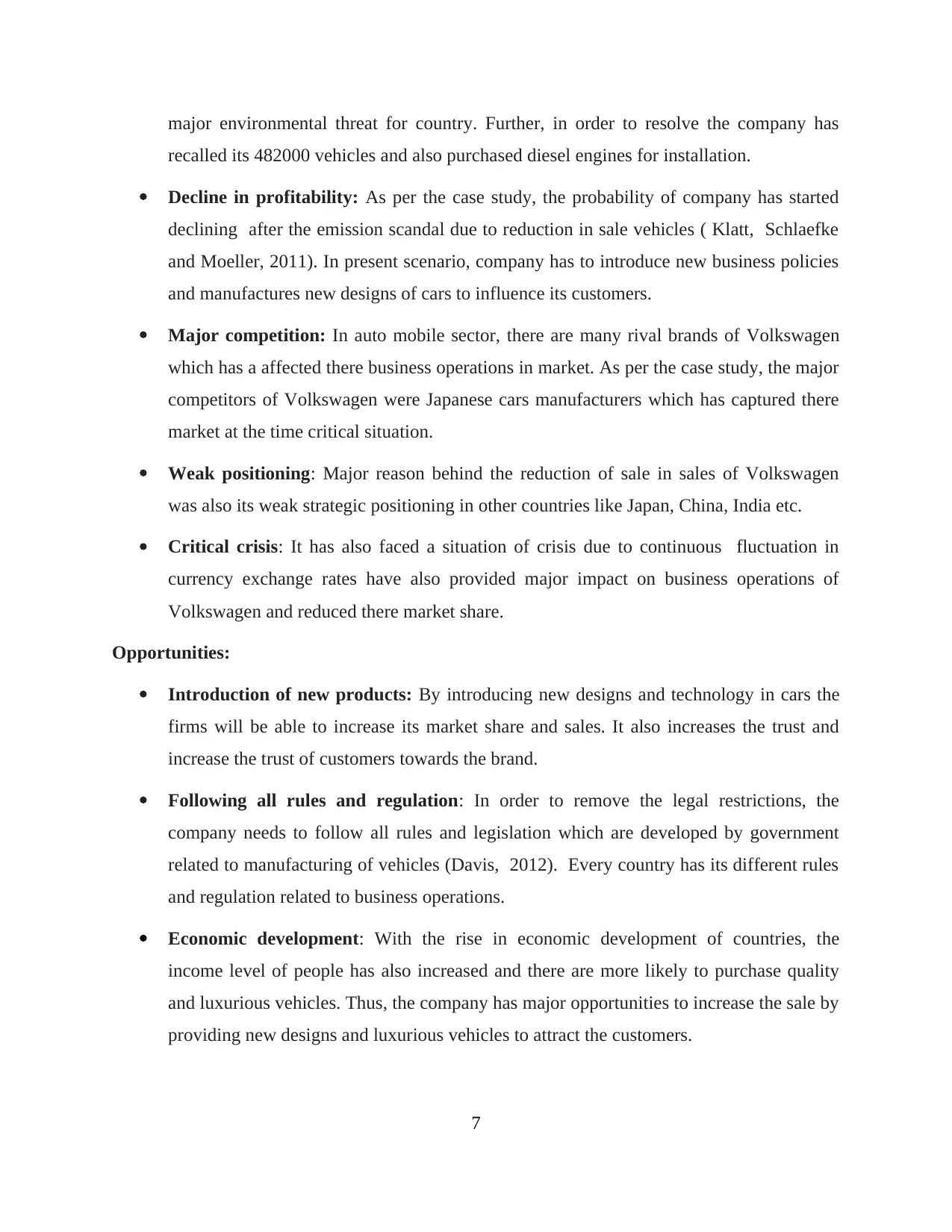
major environmental threat for country. Further, in order to resolve the company has
recalled its 482000 vehicles and also purchased diesel engines for installation.
Decline in profitability: As per the case study, the probability of company has started
declining after the emission scandal due to reduction in sale vehicles ( Klatt, Schlaefke
and Moeller, 2011). In present scenario, company has to introduce new business policies
and manufactures new designs of cars to influence its customers.
Major competition: In auto mobile sector, there are many rival brands of Volkswagen
which has a affected there business operations in market. As per the case study, the major
competitors of Volkswagen were Japanese cars manufacturers which has captured there
market at the time critical situation.
Weak positioning: Major reason behind the reduction of sale in sales of Volkswagen
was also its weak strategic positioning in other countries like Japan, China, India etc.
Critical crisis: It has also faced a situation of crisis due to continuous fluctuation in
currency exchange rates have also provided major impact on business operations of
Volkswagen and reduced there market share.
Opportunities:
Introduction of new products: By introducing new designs and technology in cars the
firms will be able to increase its market share and sales. It also increases the trust and
increase the trust of customers towards the brand.
Following all rules and regulation: In order to remove the legal restrictions, the
company needs to follow all rules and legislation which are developed by government
related to manufacturing of vehicles (Davis, 2012). Every country has its different rules
and regulation related to business operations.
Economic development: With the rise in economic development of countries, the
income level of people has also increased and there are more likely to purchase quality
and luxurious vehicles. Thus, the company has major opportunities to increase the sale by
providing new designs and luxurious vehicles to attract the customers.
7
recalled its 482000 vehicles and also purchased diesel engines for installation.
Decline in profitability: As per the case study, the probability of company has started
declining after the emission scandal due to reduction in sale vehicles ( Klatt, Schlaefke
and Moeller, 2011). In present scenario, company has to introduce new business policies
and manufactures new designs of cars to influence its customers.
Major competition: In auto mobile sector, there are many rival brands of Volkswagen
which has a affected there business operations in market. As per the case study, the major
competitors of Volkswagen were Japanese cars manufacturers which has captured there
market at the time critical situation.
Weak positioning: Major reason behind the reduction of sale in sales of Volkswagen
was also its weak strategic positioning in other countries like Japan, China, India etc.
Critical crisis: It has also faced a situation of crisis due to continuous fluctuation in
currency exchange rates have also provided major impact on business operations of
Volkswagen and reduced there market share.
Opportunities:
Introduction of new products: By introducing new designs and technology in cars the
firms will be able to increase its market share and sales. It also increases the trust and
increase the trust of customers towards the brand.
Following all rules and regulation: In order to remove the legal restrictions, the
company needs to follow all rules and legislation which are developed by government
related to manufacturing of vehicles (Davis, 2012). Every country has its different rules
and regulation related to business operations.
Economic development: With the rise in economic development of countries, the
income level of people has also increased and there are more likely to purchase quality
and luxurious vehicles. Thus, the company has major opportunities to increase the sale by
providing new designs and luxurious vehicles to attract the customers.
7
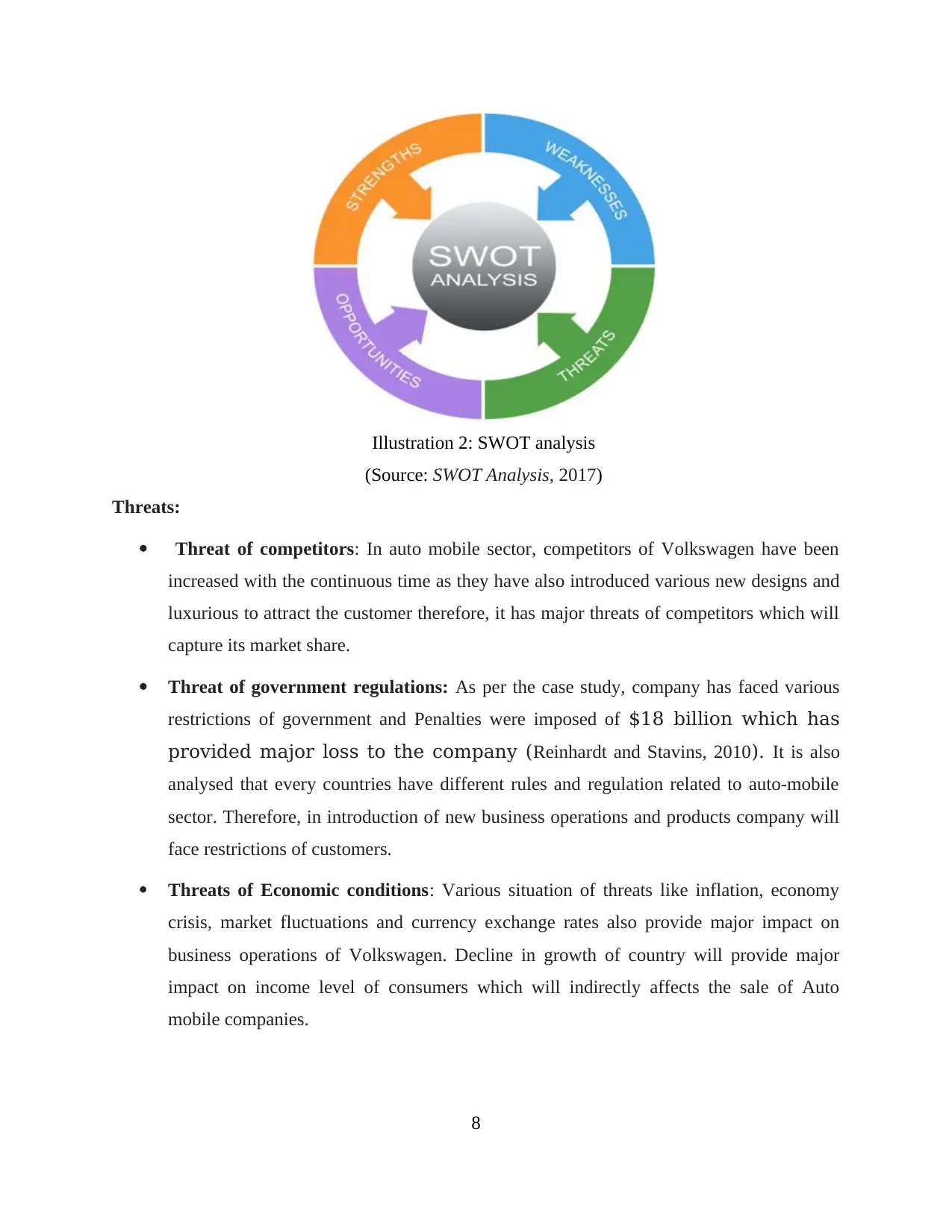
Threats:
Threat of competitors: In auto mobile sector, competitors of Volkswagen have been
increased with the continuous time as they have also introduced various new designs and
luxurious to attract the customer therefore, it has major threats of competitors which will
capture its market share.
Threat of government regulations: As per the case study, company has faced various
restrictions of government and Penalties were imposed of $18 billion which has
provided major loss to the company (Reinhardt and Stavins, 2010). It is also
analysed that every countries have different rules and regulation related to auto-mobile
sector. Therefore, in introduction of new business operations and products company will
face restrictions of customers.
Threats of Economic conditions: Various situation of threats like inflation, economy
crisis, market fluctuations and currency exchange rates also provide major impact on
business operations of Volkswagen. Decline in growth of country will provide major
impact on income level of consumers which will indirectly affects the sale of Auto
mobile companies.
8
Illustration 2: SWOT analysis
(Source: SWOT Analysis, 2017)
Threat of competitors: In auto mobile sector, competitors of Volkswagen have been
increased with the continuous time as they have also introduced various new designs and
luxurious to attract the customer therefore, it has major threats of competitors which will
capture its market share.
Threat of government regulations: As per the case study, company has faced various
restrictions of government and Penalties were imposed of $18 billion which has
provided major loss to the company (Reinhardt and Stavins, 2010). It is also
analysed that every countries have different rules and regulation related to auto-mobile
sector. Therefore, in introduction of new business operations and products company will
face restrictions of customers.
Threats of Economic conditions: Various situation of threats like inflation, economy
crisis, market fluctuations and currency exchange rates also provide major impact on
business operations of Volkswagen. Decline in growth of country will provide major
impact on income level of consumers which will indirectly affects the sale of Auto
mobile companies.
8
Illustration 2: SWOT analysis
(Source: SWOT Analysis, 2017)
Paraphrase This Document
Need a fresh take? Get an instant paraphrase of this document with our AI Paraphraser
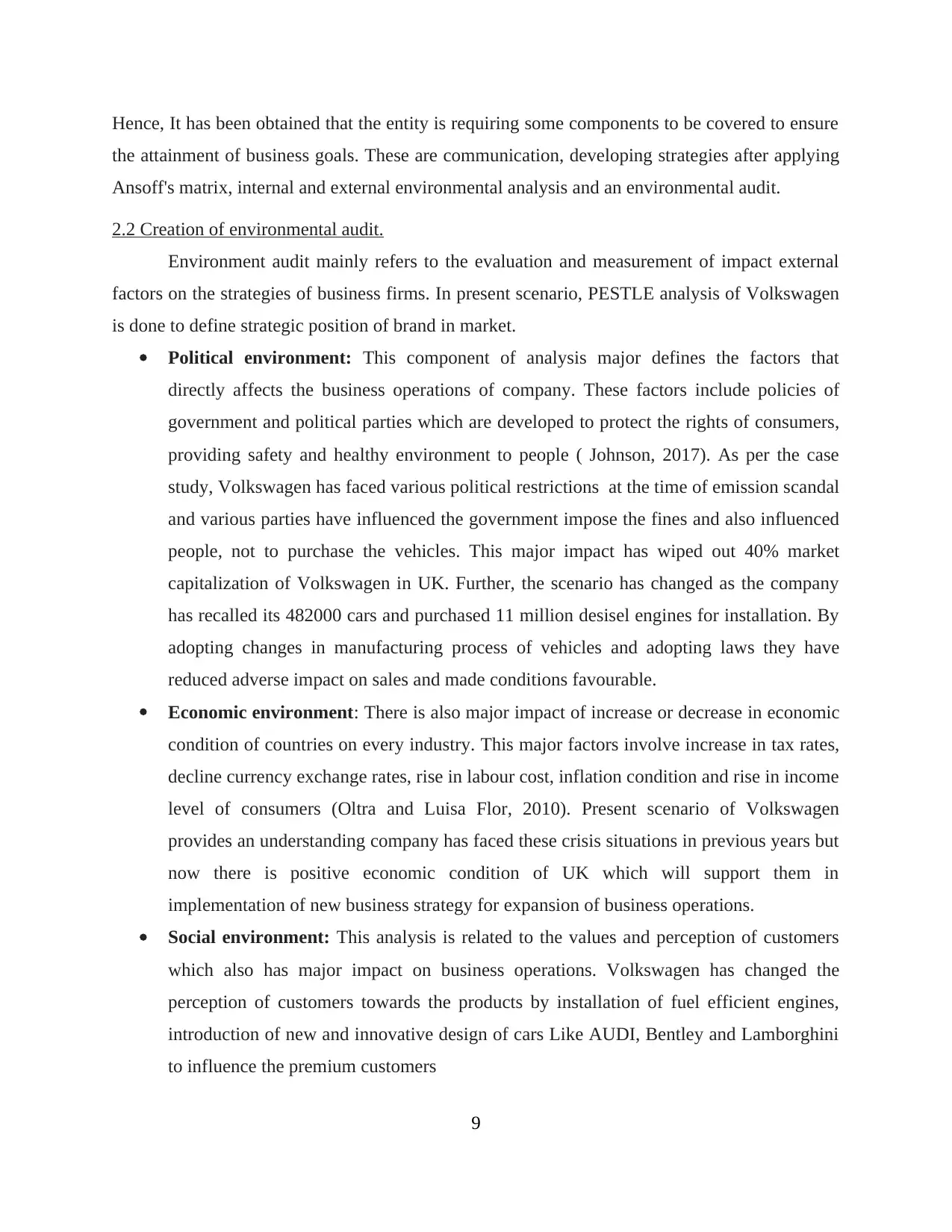
Hence, It has been obtained that the entity is requiring some components to be covered to ensure
the attainment of business goals. These are communication, developing strategies after applying
Ansoff's matrix, internal and external environmental analysis and an environmental audit.
2.2 Creation of environmental audit.
Environment audit mainly refers to the evaluation and measurement of impact external
factors on the strategies of business firms. In present scenario, PESTLE analysis of Volkswagen
is done to define strategic position of brand in market.
Political environment: This component of analysis major defines the factors that
directly affects the business operations of company. These factors include policies of
government and political parties which are developed to protect the rights of consumers,
providing safety and healthy environment to people ( Johnson, 2017). As per the case
study, Volkswagen has faced various political restrictions at the time of emission scandal
and various parties have influenced the government impose the fines and also influenced
people, not to purchase the vehicles. This major impact has wiped out 40% market
capitalization of Volkswagen in UK. Further, the scenario has changed as the company
has recalled its 482000 cars and purchased 11 million desisel engines for installation. By
adopting changes in manufacturing process of vehicles and adopting laws they have
reduced adverse impact on sales and made conditions favourable.
Economic environment: There is also major impact of increase or decrease in economic
condition of countries on every industry. This major factors involve increase in tax rates,
decline currency exchange rates, rise in labour cost, inflation condition and rise in income
level of consumers (Oltra and Luisa Flor, 2010). Present scenario of Volkswagen
provides an understanding company has faced these crisis situations in previous years but
now there is positive economic condition of UK which will support them in
implementation of new business strategy for expansion of business operations.
Social environment: This analysis is related to the values and perception of customers
which also has major impact on business operations. Volkswagen has changed the
perception of customers towards the products by installation of fuel efficient engines,
introduction of new and innovative design of cars Like AUDI, Bentley and Lamborghini
to influence the premium customers
9
the attainment of business goals. These are communication, developing strategies after applying
Ansoff's matrix, internal and external environmental analysis and an environmental audit.
2.2 Creation of environmental audit.
Environment audit mainly refers to the evaluation and measurement of impact external
factors on the strategies of business firms. In present scenario, PESTLE analysis of Volkswagen
is done to define strategic position of brand in market.
Political environment: This component of analysis major defines the factors that
directly affects the business operations of company. These factors include policies of
government and political parties which are developed to protect the rights of consumers,
providing safety and healthy environment to people ( Johnson, 2017). As per the case
study, Volkswagen has faced various political restrictions at the time of emission scandal
and various parties have influenced the government impose the fines and also influenced
people, not to purchase the vehicles. This major impact has wiped out 40% market
capitalization of Volkswagen in UK. Further, the scenario has changed as the company
has recalled its 482000 cars and purchased 11 million desisel engines for installation. By
adopting changes in manufacturing process of vehicles and adopting laws they have
reduced adverse impact on sales and made conditions favourable.
Economic environment: There is also major impact of increase or decrease in economic
condition of countries on every industry. This major factors involve increase in tax rates,
decline currency exchange rates, rise in labour cost, inflation condition and rise in income
level of consumers (Oltra and Luisa Flor, 2010). Present scenario of Volkswagen
provides an understanding company has faced these crisis situations in previous years but
now there is positive economic condition of UK which will support them in
implementation of new business strategy for expansion of business operations.
Social environment: This analysis is related to the values and perception of customers
which also has major impact on business operations. Volkswagen has changed the
perception of customers towards the products by installation of fuel efficient engines,
introduction of new and innovative design of cars Like AUDI, Bentley and Lamborghini
to influence the premium customers
9
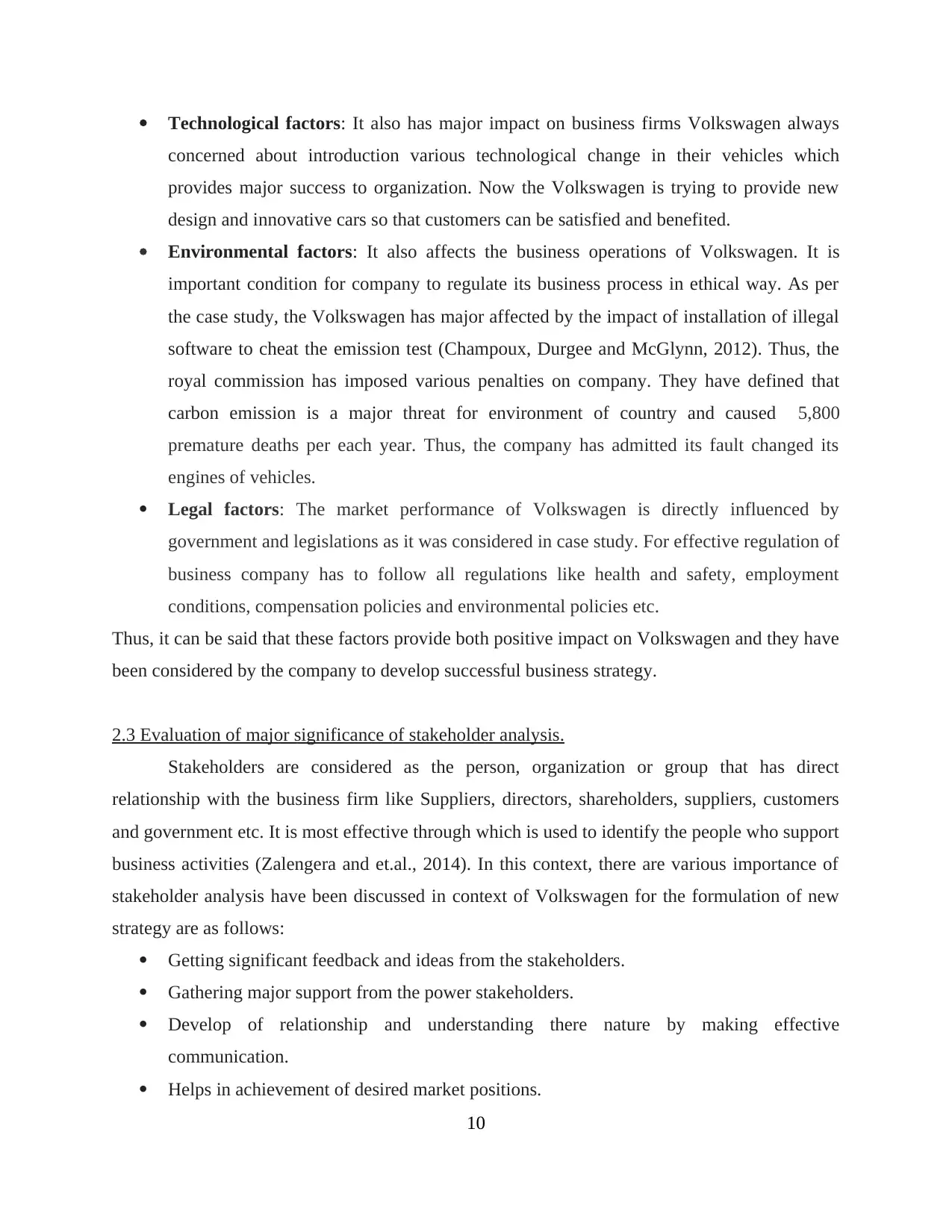
Technological factors: It also has major impact on business firms Volkswagen always
concerned about introduction various technological change in their vehicles which
provides major success to organization. Now the Volkswagen is trying to provide new
design and innovative cars so that customers can be satisfied and benefited.
Environmental factors: It also affects the business operations of Volkswagen. It is
important condition for company to regulate its business process in ethical way. As per
the case study, the Volkswagen has major affected by the impact of installation of illegal
software to cheat the emission test (Champoux, Durgee and McGlynn, 2012). Thus, the
royal commission has imposed various penalties on company. They have defined that
carbon emission is a major threat for environment of country and caused 5,800
premature deaths per each year. Thus, the company has admitted its fault changed its
engines of vehicles.
Legal factors: The market performance of Volkswagen is directly influenced by
government and legislations as it was considered in case study. For effective regulation of
business company has to follow all regulations like health and safety, employment
conditions, compensation policies and environmental policies etc.
Thus, it can be said that these factors provide both positive impact on Volkswagen and they have
been considered by the company to develop successful business strategy.
2.3 Evaluation of major significance of stakeholder analysis.
Stakeholders are considered as the person, organization or group that has direct
relationship with the business firm like Suppliers, directors, shareholders, suppliers, customers
and government etc. It is most effective through which is used to identify the people who support
business activities (Zalengera and et.al., 2014). In this context, there are various importance of
stakeholder analysis have been discussed in context of Volkswagen for the formulation of new
strategy are as follows:
Getting significant feedback and ideas from the stakeholders.
Gathering major support from the power stakeholders.
Develop of relationship and understanding there nature by making effective
communication.
Helps in achievement of desired market positions.
10
concerned about introduction various technological change in their vehicles which
provides major success to organization. Now the Volkswagen is trying to provide new
design and innovative cars so that customers can be satisfied and benefited.
Environmental factors: It also affects the business operations of Volkswagen. It is
important condition for company to regulate its business process in ethical way. As per
the case study, the Volkswagen has major affected by the impact of installation of illegal
software to cheat the emission test (Champoux, Durgee and McGlynn, 2012). Thus, the
royal commission has imposed various penalties on company. They have defined that
carbon emission is a major threat for environment of country and caused 5,800
premature deaths per each year. Thus, the company has admitted its fault changed its
engines of vehicles.
Legal factors: The market performance of Volkswagen is directly influenced by
government and legislations as it was considered in case study. For effective regulation of
business company has to follow all regulations like health and safety, employment
conditions, compensation policies and environmental policies etc.
Thus, it can be said that these factors provide both positive impact on Volkswagen and they have
been considered by the company to develop successful business strategy.
2.3 Evaluation of major significance of stakeholder analysis.
Stakeholders are considered as the person, organization or group that has direct
relationship with the business firm like Suppliers, directors, shareholders, suppliers, customers
and government etc. It is most effective through which is used to identify the people who support
business activities (Zalengera and et.al., 2014). In this context, there are various importance of
stakeholder analysis have been discussed in context of Volkswagen for the formulation of new
strategy are as follows:
Getting significant feedback and ideas from the stakeholders.
Gathering major support from the power stakeholders.
Develop of relationship and understanding there nature by making effective
communication.
Helps in achievement of desired market positions.
10

Helps in influencing the shareholder and getting the financial resources from institutions.
2.4 Presentation of new business strategy for company.
In this, several factors have been discussed that gives a clear reflection that there is need of
appropriate plans and strategies that organization should follow to achieve the mission, vision
and objectives ( Fox, 2012). In this context , for the development effective business ansoff matrix
is being used which has four different stages like market penetration, product development,
market development and diversification.
Market penetration describes that the firms should sustain in present market where they
are continuing there business operations by applying various innovation in their products like
installation of fuel efficient engines, various technological changes, new designs and features. It
is considered as effective strategy for the firm to survive in competitive market and sccess in
business operations. Apart from this, in order to gain trust of competitors, it also has to invest its
capital on marketing and promotion of products.
11
Illustration 3: Ansoff matrix
(Source: Ansoff Matrix , 2017)
2.4 Presentation of new business strategy for company.
In this, several factors have been discussed that gives a clear reflection that there is need of
appropriate plans and strategies that organization should follow to achieve the mission, vision
and objectives ( Fox, 2012). In this context , for the development effective business ansoff matrix
is being used which has four different stages like market penetration, product development,
market development and diversification.
Market penetration describes that the firms should sustain in present market where they
are continuing there business operations by applying various innovation in their products like
installation of fuel efficient engines, various technological changes, new designs and features. It
is considered as effective strategy for the firm to survive in competitive market and sccess in
business operations. Apart from this, in order to gain trust of competitors, it also has to invest its
capital on marketing and promotion of products.
11
Illustration 3: Ansoff matrix
(Source: Ansoff Matrix , 2017)
Secure Best Marks with AI Grader
Need help grading? Try our AI Grader for instant feedback on your assignments.
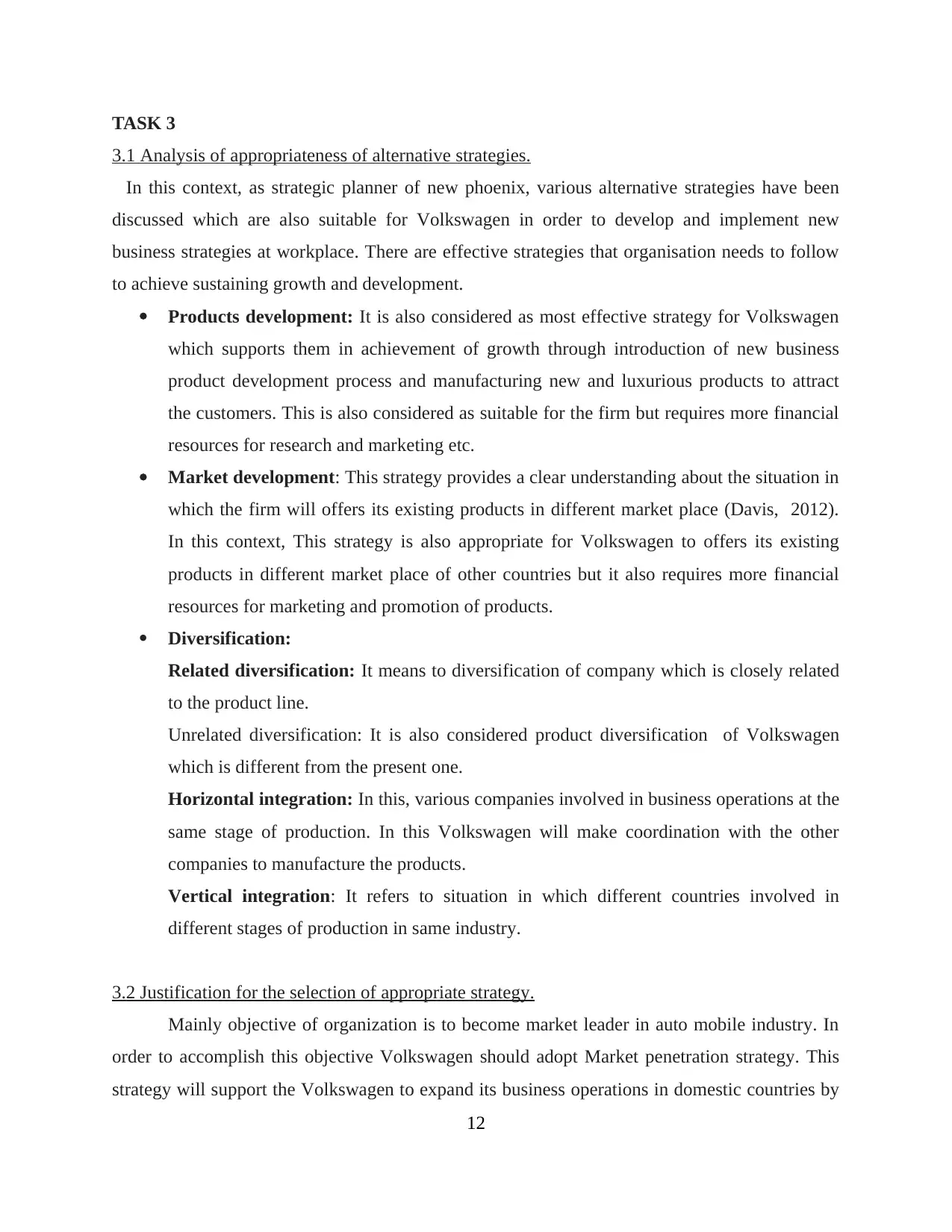
TASK 3
3.1 Analysis of appropriateness of alternative strategies.
In this context, as strategic planner of new phoenix, various alternative strategies have been
discussed which are also suitable for Volkswagen in order to develop and implement new
business strategies at workplace. There are effective strategies that organisation needs to follow
to achieve sustaining growth and development.
Products development: It is also considered as most effective strategy for Volkswagen
which supports them in achievement of growth through introduction of new business
product development process and manufacturing new and luxurious products to attract
the customers. This is also considered as suitable for the firm but requires more financial
resources for research and marketing etc.
Market development: This strategy provides a clear understanding about the situation in
which the firm will offers its existing products in different market place (Davis, 2012).
In this context, This strategy is also appropriate for Volkswagen to offers its existing
products in different market place of other countries but it also requires more financial
resources for marketing and promotion of products.
Diversification:
Related diversification: It means to diversification of company which is closely related
to the product line.
Unrelated diversification: It is also considered product diversification of Volkswagen
which is different from the present one.
Horizontal integration: In this, various companies involved in business operations at the
same stage of production. In this Volkswagen will make coordination with the other
companies to manufacture the products.
Vertical integration: It refers to situation in which different countries involved in
different stages of production in same industry.
3.2 Justification for the selection of appropriate strategy.
Mainly objective of organization is to become market leader in auto mobile industry. In
order to accomplish this objective Volkswagen should adopt Market penetration strategy. This
strategy will support the Volkswagen to expand its business operations in domestic countries by
12
3.1 Analysis of appropriateness of alternative strategies.
In this context, as strategic planner of new phoenix, various alternative strategies have been
discussed which are also suitable for Volkswagen in order to develop and implement new
business strategies at workplace. There are effective strategies that organisation needs to follow
to achieve sustaining growth and development.
Products development: It is also considered as most effective strategy for Volkswagen
which supports them in achievement of growth through introduction of new business
product development process and manufacturing new and luxurious products to attract
the customers. This is also considered as suitable for the firm but requires more financial
resources for research and marketing etc.
Market development: This strategy provides a clear understanding about the situation in
which the firm will offers its existing products in different market place (Davis, 2012).
In this context, This strategy is also appropriate for Volkswagen to offers its existing
products in different market place of other countries but it also requires more financial
resources for marketing and promotion of products.
Diversification:
Related diversification: It means to diversification of company which is closely related
to the product line.
Unrelated diversification: It is also considered product diversification of Volkswagen
which is different from the present one.
Horizontal integration: In this, various companies involved in business operations at the
same stage of production. In this Volkswagen will make coordination with the other
companies to manufacture the products.
Vertical integration: It refers to situation in which different countries involved in
different stages of production in same industry.
3.2 Justification for the selection of appropriate strategy.
Mainly objective of organization is to become market leader in auto mobile industry. In
order to accomplish this objective Volkswagen should adopt Market penetration strategy. This
strategy will support the Volkswagen to expand its business operations in domestic countries by
12
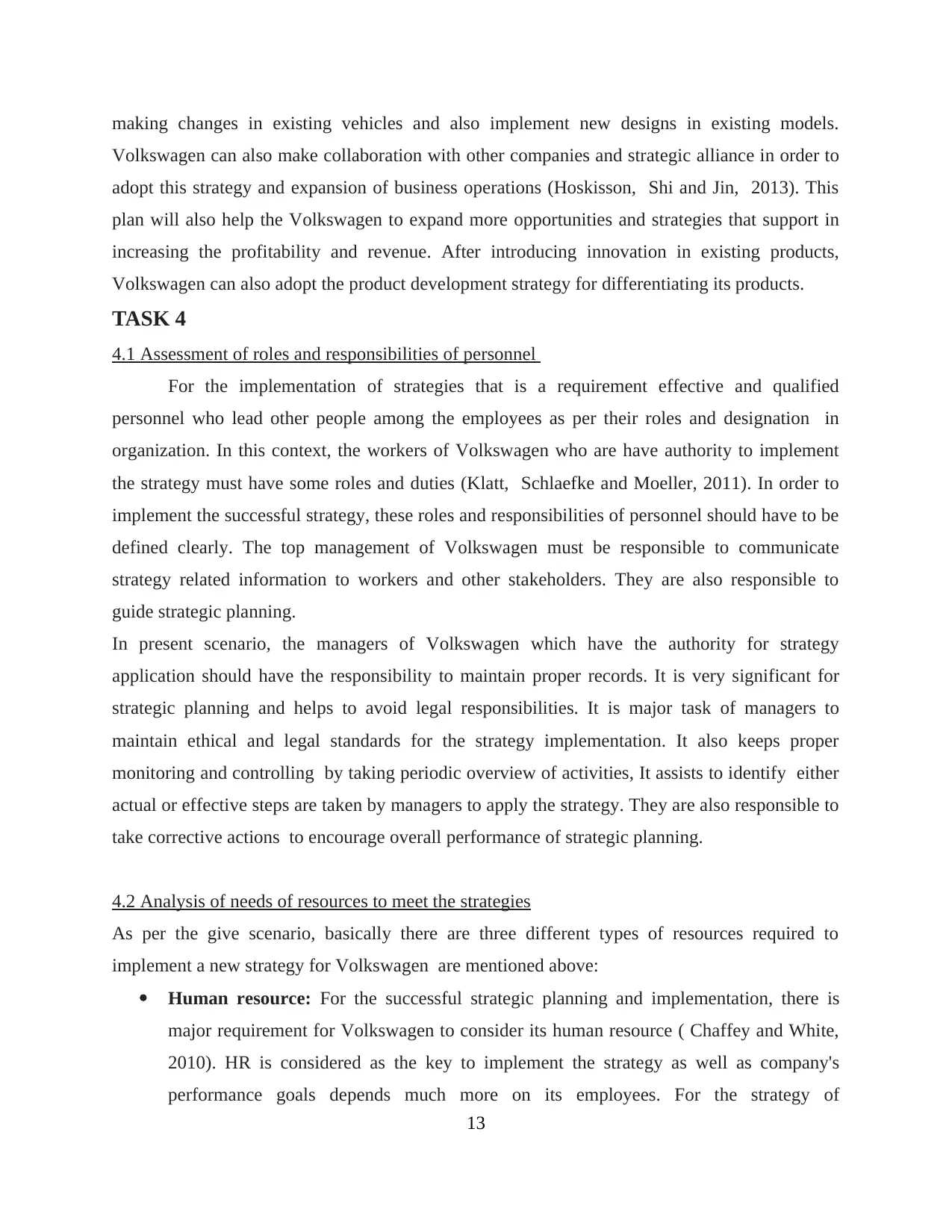
making changes in existing vehicles and also implement new designs in existing models.
Volkswagen can also make collaboration with other companies and strategic alliance in order to
adopt this strategy and expansion of business operations (Hoskisson, Shi and Jin, 2013). This
plan will also help the Volkswagen to expand more opportunities and strategies that support in
increasing the profitability and revenue. After introducing innovation in existing products,
Volkswagen can also adopt the product development strategy for differentiating its products.
TASK 4
4.1 Assessment of roles and responsibilities of personnel
For the implementation of strategies that is a requirement effective and qualified
personnel who lead other people among the employees as per their roles and designation in
organization. In this context, the workers of Volkswagen who are have authority to implement
the strategy must have some roles and duties (Klatt, Schlaefke and Moeller, 2011). In order to
implement the successful strategy, these roles and responsibilities of personnel should have to be
defined clearly. The top management of Volkswagen must be responsible to communicate
strategy related information to workers and other stakeholders. They are also responsible to
guide strategic planning.
In present scenario, the managers of Volkswagen which have the authority for strategy
application should have the responsibility to maintain proper records. It is very significant for
strategic planning and helps to avoid legal responsibilities. It is major task of managers to
maintain ethical and legal standards for the strategy implementation. It also keeps proper
monitoring and controlling by taking periodic overview of activities, It assists to identify either
actual or effective steps are taken by managers to apply the strategy. They are also responsible to
take corrective actions to encourage overall performance of strategic planning.
4.2 Analysis of needs of resources to meet the strategies
As per the give scenario, basically there are three different types of resources required to
implement a new strategy for Volkswagen are mentioned above:
Human resource: For the successful strategic planning and implementation, there is
major requirement for Volkswagen to consider its human resource ( Chaffey and White,
2010). HR is considered as the key to implement the strategy as well as company's
performance goals depends much more on its employees. For the strategy of
13
Volkswagen can also make collaboration with other companies and strategic alliance in order to
adopt this strategy and expansion of business operations (Hoskisson, Shi and Jin, 2013). This
plan will also help the Volkswagen to expand more opportunities and strategies that support in
increasing the profitability and revenue. After introducing innovation in existing products,
Volkswagen can also adopt the product development strategy for differentiating its products.
TASK 4
4.1 Assessment of roles and responsibilities of personnel
For the implementation of strategies that is a requirement effective and qualified
personnel who lead other people among the employees as per their roles and designation in
organization. In this context, the workers of Volkswagen who are have authority to implement
the strategy must have some roles and duties (Klatt, Schlaefke and Moeller, 2011). In order to
implement the successful strategy, these roles and responsibilities of personnel should have to be
defined clearly. The top management of Volkswagen must be responsible to communicate
strategy related information to workers and other stakeholders. They are also responsible to
guide strategic planning.
In present scenario, the managers of Volkswagen which have the authority for strategy
application should have the responsibility to maintain proper records. It is very significant for
strategic planning and helps to avoid legal responsibilities. It is major task of managers to
maintain ethical and legal standards for the strategy implementation. It also keeps proper
monitoring and controlling by taking periodic overview of activities, It assists to identify either
actual or effective steps are taken by managers to apply the strategy. They are also responsible to
take corrective actions to encourage overall performance of strategic planning.
4.2 Analysis of needs of resources to meet the strategies
As per the give scenario, basically there are three different types of resources required to
implement a new strategy for Volkswagen are mentioned above:
Human resource: For the successful strategic planning and implementation, there is
major requirement for Volkswagen to consider its human resource ( Chaffey and White,
2010). HR is considered as the key to implement the strategy as well as company's
performance goals depends much more on its employees. For the strategy of
13

Volkswagen, there is major requirement of effective and expert workforce who enough
technical knowledge and productivity to provide new and innovative for the innovating
existing products .
Financial resource: This strategy is refers to sources through which Volkswagen finance
their plans to make it more effective (Shirey, 2011). Finance will be achieved in two
ways Debt or equity. Equity is more preferable as there is no interest is charged on the
cost of capital.
Time and material resource: For every plan or strategy there is always a specific time
limit and some material required to implement the project. Volkswagen has to use
modern technology , machine to accomplish there adopted penetration strategy.
4.3 Evaluation of the contribution of SMART goals.
Through SMART targets which is Fixed by the company Volkswagen that must be classified in
nature, measurable with established criteria, which is attainable in specific time duration and that
should be realistic.
Significance of SMART targets
When the objectives are not specific that what the company desire to achieve then the
entire effort will get wasted or go in vain for the critical condition (Campbell, Edgar and
Stonehouse, 2011).
It is also considered if the objectives are not measurable as per the established targets
then it is not possible for the company identify opportunities.
If Volks set the target that is unattainable then they will not able to achieve its desired
position.
Apart from the analysis, It is defined that Volkswagen has developed an objective of attaining
20% rise in market share in every quarter which is attainable and also considered as time bound.
Therefore, it can be said that it will provide major benefits to the company in implementation of
successful business strategy.
CONCLUSION
In present report, it has been concluded that the every organization needs to
develop effective business strategy to achieve success in business operations. It
will also consider as beneficial for them to achieve desired market position and
14
technical knowledge and productivity to provide new and innovative for the innovating
existing products .
Financial resource: This strategy is refers to sources through which Volkswagen finance
their plans to make it more effective (Shirey, 2011). Finance will be achieved in two
ways Debt or equity. Equity is more preferable as there is no interest is charged on the
cost of capital.
Time and material resource: For every plan or strategy there is always a specific time
limit and some material required to implement the project. Volkswagen has to use
modern technology , machine to accomplish there adopted penetration strategy.
4.3 Evaluation of the contribution of SMART goals.
Through SMART targets which is Fixed by the company Volkswagen that must be classified in
nature, measurable with established criteria, which is attainable in specific time duration and that
should be realistic.
Significance of SMART targets
When the objectives are not specific that what the company desire to achieve then the
entire effort will get wasted or go in vain for the critical condition (Campbell, Edgar and
Stonehouse, 2011).
It is also considered if the objectives are not measurable as per the established targets
then it is not possible for the company identify opportunities.
If Volks set the target that is unattainable then they will not able to achieve its desired
position.
Apart from the analysis, It is defined that Volkswagen has developed an objective of attaining
20% rise in market share in every quarter which is attainable and also considered as time bound.
Therefore, it can be said that it will provide major benefits to the company in implementation of
successful business strategy.
CONCLUSION
In present report, it has been concluded that the every organization needs to
develop effective business strategy to achieve success in business operations. It
will also consider as beneficial for them to achieve desired market position and
14
Paraphrase This Document
Need a fresh take? Get an instant paraphrase of this document with our AI Paraphraser

achieve the set targets. The strategic position of the company is analysed in the
report. Further, internal analysis has also been done to evaluate the factors that can
made or made the identity of the entity. Pestle analysis also provides completed
understanding that these factors will provide both positive and negative impact on
business operations of Volkswagen. Thus, they need to consider there requirement
to considered at time of development and implementation of strategies.
15
report. Further, internal analysis has also been done to evaluate the factors that can
made or made the identity of the entity. Pestle analysis also provides completed
understanding that these factors will provide both positive and negative impact on
business operations of Volkswagen. Thus, they need to consider there requirement
to considered at time of development and implementation of strategies.
15
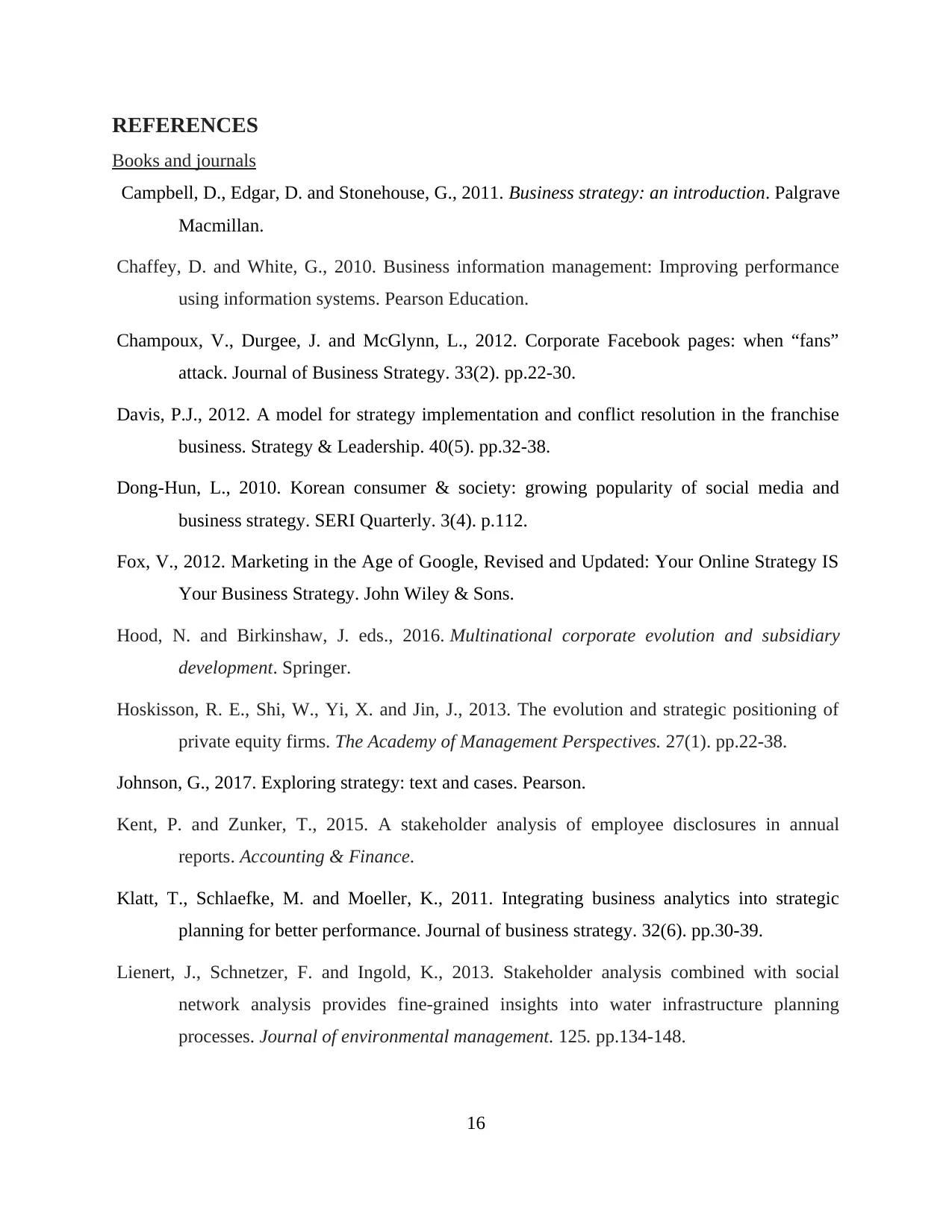
REFERENCES
Books and journals
Campbell, D., Edgar, D. and Stonehouse, G., 2011. Business strategy: an introduction. Palgrave
Macmillan.
Chaffey, D. and White, G., 2010. Business information management: Improving performance
using information systems. Pearson Education.
Champoux, V., Durgee, J. and McGlynn, L., 2012. Corporate Facebook pages: when “fans”
attack. Journal of Business Strategy. 33(2). pp.22-30.
Davis, P.J., 2012. A model for strategy implementation and conflict resolution in the franchise
business. Strategy & Leadership. 40(5). pp.32-38.
Dong-Hun, L., 2010. Korean consumer & society: growing popularity of social media and
business strategy. SERI Quarterly. 3(4). p.112.
Fox, V., 2012. Marketing in the Age of Google, Revised and Updated: Your Online Strategy IS
Your Business Strategy. John Wiley & Sons.
Hood, N. and Birkinshaw, J. eds., 2016. Multinational corporate evolution and subsidiary
development. Springer.
Hoskisson, R. E., Shi, W., Yi, X. and Jin, J., 2013. The evolution and strategic positioning of
private equity firms. The Academy of Management Perspectives. 27(1). pp.22-38.
Johnson, G., 2017. Exploring strategy: text and cases. Pearson.
Kent, P. and Zunker, T., 2015. A stakeholder analysis of employee disclosures in annual
reports. Accounting & Finance.
Klatt, T., Schlaefke, M. and Moeller, K., 2011. Integrating business analytics into strategic
planning for better performance. Journal of business strategy. 32(6). pp.30-39.
Lienert, J., Schnetzer, F. and Ingold, K., 2013. Stakeholder analysis combined with social
network analysis provides fine-grained insights into water infrastructure planning
processes. Journal of environmental management. 125. pp.134-148.
16
Books and journals
Campbell, D., Edgar, D. and Stonehouse, G., 2011. Business strategy: an introduction. Palgrave
Macmillan.
Chaffey, D. and White, G., 2010. Business information management: Improving performance
using information systems. Pearson Education.
Champoux, V., Durgee, J. and McGlynn, L., 2012. Corporate Facebook pages: when “fans”
attack. Journal of Business Strategy. 33(2). pp.22-30.
Davis, P.J., 2012. A model for strategy implementation and conflict resolution in the franchise
business. Strategy & Leadership. 40(5). pp.32-38.
Dong-Hun, L., 2010. Korean consumer & society: growing popularity of social media and
business strategy. SERI Quarterly. 3(4). p.112.
Fox, V., 2012. Marketing in the Age of Google, Revised and Updated: Your Online Strategy IS
Your Business Strategy. John Wiley & Sons.
Hood, N. and Birkinshaw, J. eds., 2016. Multinational corporate evolution and subsidiary
development. Springer.
Hoskisson, R. E., Shi, W., Yi, X. and Jin, J., 2013. The evolution and strategic positioning of
private equity firms. The Academy of Management Perspectives. 27(1). pp.22-38.
Johnson, G., 2017. Exploring strategy: text and cases. Pearson.
Kent, P. and Zunker, T., 2015. A stakeholder analysis of employee disclosures in annual
reports. Accounting & Finance.
Klatt, T., Schlaefke, M. and Moeller, K., 2011. Integrating business analytics into strategic
planning for better performance. Journal of business strategy. 32(6). pp.30-39.
Lienert, J., Schnetzer, F. and Ingold, K., 2013. Stakeholder analysis combined with social
network analysis provides fine-grained insights into water infrastructure planning
processes. Journal of environmental management. 125. pp.134-148.
16

Norton, J., 2014. A how-to: Conduct an environmental audit in your library. OLA
Quarterly. 13(4). pp.7-11.
Oltra, M.J. and Luisa Flor, M., 2010. The moderating effect of business strategy on the
relationship between operations strategy and firms' results. International Journal of
Operations & Production Management. 30(6). pp.612-638.
Reinhardt, F.L. and Stavins, R.N., 2010. Corporate social responsibility, business strategy, and
the environment. Oxford Review of Economic Policy. 26(2). pp.164-181.
Shirey, M.R., 2011. Addressing strategy execution challenges to lead sustainable change.
Journal of Nursing Administration. 41(1). pp.1-4.
Wæraas, A., 2015. Making a difference: Strategic positioning in municipal reputation
building. Local government studies. 41(2). pp.280-300.
Wüstemeyer, C., Madlener, R. and Bunn, D.W., 2015. A stakeholder analysis of divergent
supply-chain trends for the European onshore and offshore wind installations. Energy
Policy. 80. pp.36-44.
Yang, J., 2017. Audit Oversight. In Environmental Management in Mega Construction
Projects (pp. 289-306). Springer Singapore.
Zalengera, C., Blanchard, R. E., Eames, P. C., Juma, A. M., Chitawo, M. L. and Gondwe, K. T.,
2014. Overview of the Malawi energy situation and A PESTLE analysis for sustainable
development of renewable energy. Renewable and Sustainable Energy Reviews. 38.
pp.335-347.
Online
Ansoff Matrix , 2017. [Online]. Available through :
<https://www.professionalacademy.com/blogs-and-advice/marketing-theories---
explaining-the-ansoff-matrix-/ >
BCG Growth-Share Matrix, 2017. [Online]. Available through :
<https://www.234finance.com/rate-your-start-up-stars-cash-cows-dogs-or-question-
marks/>
17
Quarterly. 13(4). pp.7-11.
Oltra, M.J. and Luisa Flor, M., 2010. The moderating effect of business strategy on the
relationship between operations strategy and firms' results. International Journal of
Operations & Production Management. 30(6). pp.612-638.
Reinhardt, F.L. and Stavins, R.N., 2010. Corporate social responsibility, business strategy, and
the environment. Oxford Review of Economic Policy. 26(2). pp.164-181.
Shirey, M.R., 2011. Addressing strategy execution challenges to lead sustainable change.
Journal of Nursing Administration. 41(1). pp.1-4.
Wæraas, A., 2015. Making a difference: Strategic positioning in municipal reputation
building. Local government studies. 41(2). pp.280-300.
Wüstemeyer, C., Madlener, R. and Bunn, D.W., 2015. A stakeholder analysis of divergent
supply-chain trends for the European onshore and offshore wind installations. Energy
Policy. 80. pp.36-44.
Yang, J., 2017. Audit Oversight. In Environmental Management in Mega Construction
Projects (pp. 289-306). Springer Singapore.
Zalengera, C., Blanchard, R. E., Eames, P. C., Juma, A. M., Chitawo, M. L. and Gondwe, K. T.,
2014. Overview of the Malawi energy situation and A PESTLE analysis for sustainable
development of renewable energy. Renewable and Sustainable Energy Reviews. 38.
pp.335-347.
Online
Ansoff Matrix , 2017. [Online]. Available through :
<https://www.professionalacademy.com/blogs-and-advice/marketing-theories---
explaining-the-ansoff-matrix-/ >
BCG Growth-Share Matrix, 2017. [Online]. Available through :
<https://www.234finance.com/rate-your-start-up-stars-cash-cows-dogs-or-question-
marks/>
17
Secure Best Marks with AI Grader
Need help grading? Try our AI Grader for instant feedback on your assignments.

SWOT Analysis, 2017. [Online]. Available through : <https://www.projectsmart.co.uk/swot-
analysis.php>
18
analysis.php>
18
1 out of 20
![[object Object]](/_next/static/media/star-bottom.7253800d.svg)





